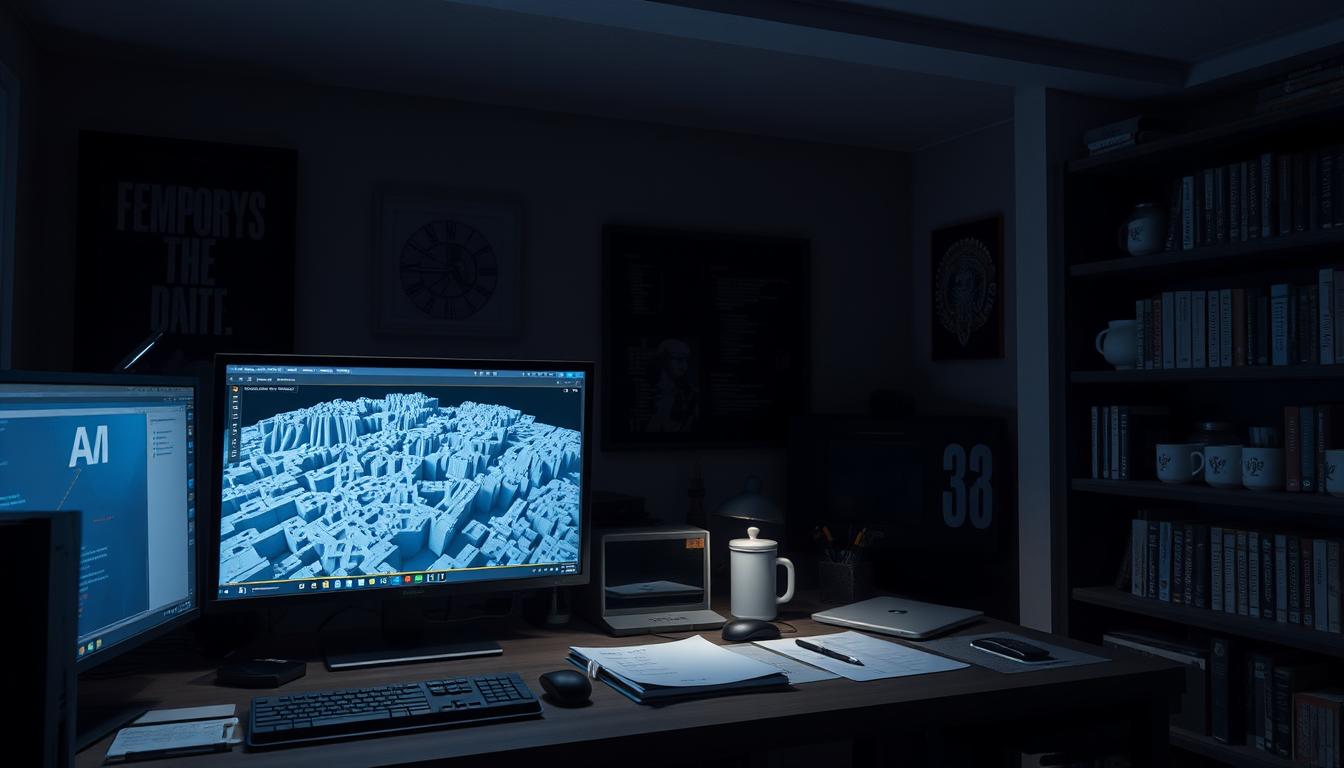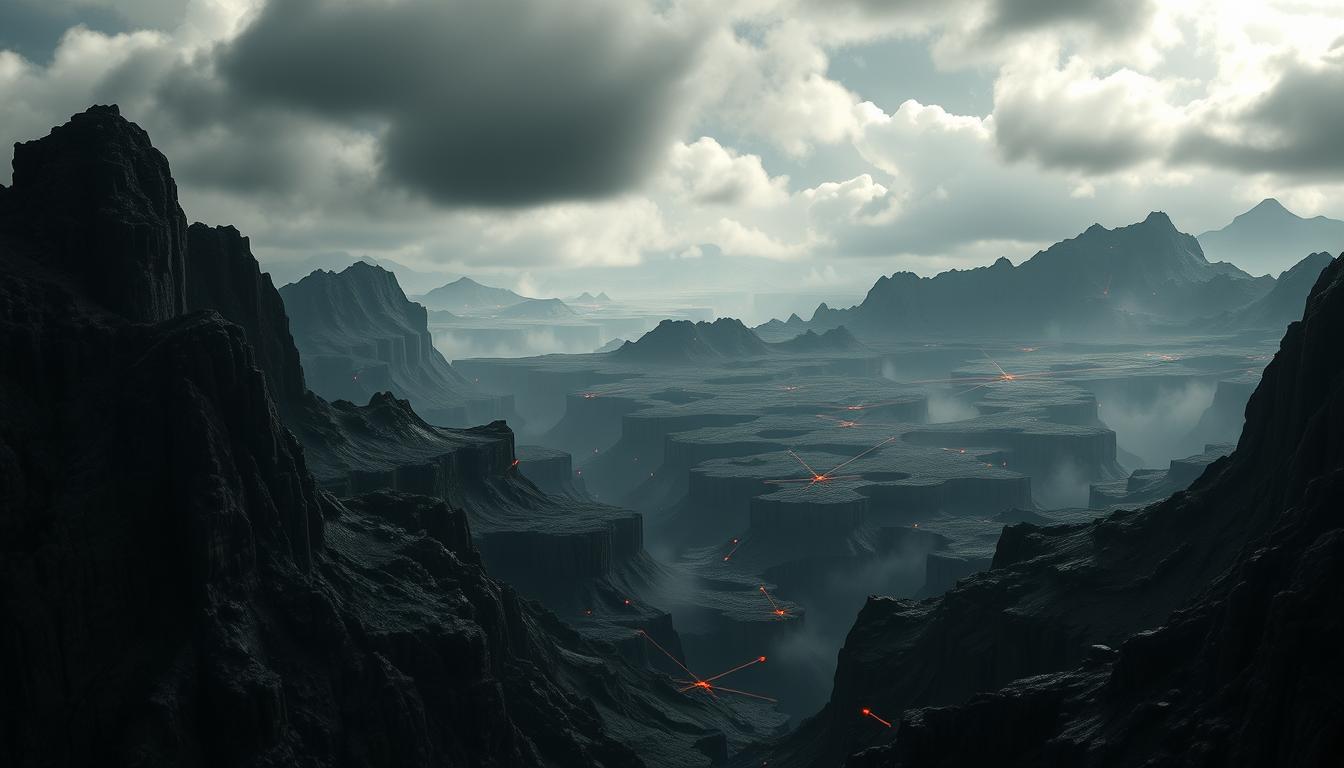Ever wondered how some games and simulations create amazing, detailed worlds without crashing your system? The key often lies in smart RAM management. RAM overload can be a big problem in making detailed procedural terrains, especially as graphics get better.
It’s crucial to manage memory well in procedural terrain generation to avoid slowdowns. We’ll look at practical ways to handle memory issues and keep the game running smoothly.
Understanding RAM Overload in Procedural Terrain Generation
RAM overload can really slow down apps that work with terrain. It happens when an app needs more memory than it has. This can make the app run slow or even crash.
Generating detailed terrains is a big part of this problem. These terrains need lots of memory to look good. As terrains get more detailed, they use even more memory.
To avoid RAM overload, it’s key to manage memory well. Developers should focus on loading and unloading assets efficiently. This helps keep the app running smoothly and makes it better for users.

Why RAM Overload Occurs in Detailed Procedural Terrains
RAM overload is a big problem in detailed procedural terrains. It’s caused by many factors. High polygon counts in complex procedural models are a main reason. These high counts can make a lot of memory work hard, especially when we need fast rendering.
Textures also play a big role in memory usage in 3D graphics. High-resolution textures make scenes look better but use a lot of RAM. As terrains get more detailed, the need for these textures grows, making memory issues worse.
Dynamic asset generation adds more complexity. As scenes change in real-time, new assets are made and updated. This can cause memory usage to jump up, leading to overload. Knowing these issues helps developers make engaging games without slowing down systems.

Techniques to Avoid RAM Overload in Detailed Procedural Terrains
To avoid RAM overload in procedural terrains, we need a smart plan. There are many ways to manage RAM and keep things running smoothly. One good method is to simplify 3D models by reducing polygon count. This makes the system work better and use resources wisely.
Using efficient data structures is also key. This way, systems can find what they need quickly and use less memory. For instance, spatial partitioning helps organize terrain data better. It makes memory use much lower.
Level-of-detail (LoD) approaches are another smart move. They let the system show more detail as you get closer to certain parts of the terrain. This way, performance stays good and visuals are sharp.
By using these methods together, we can make beautiful environments without using too much RAM. Keeping an eye on performance and tweaking as needed helps keep things balanced.
Optimizing Procedural Mesh Geometry to Enhance Memory Efficiency
To make procedural modeling more memory-efficient, optimizing mesh geometry is key. It’s important to reduce vertex count while keeping details sharp. Using techniques like instancing can greatly cut down on resource use. This is because identical objects share the same mesh data.
Dynamic level of detail (LOD) adjustments are also vital. They let applications change detail levels based on how far away the viewer is. This helps save memory and improve performance.
Special algorithms are made to optimize mesh geometry. They make sure memory use is low without losing visual quality. Using quadtrees or octrees can help manage mesh data better. These structures decide which parts of the mesh to load or unload, saving memory.
Practical methods in procedural modeling use these techniques well. By doing so, they ensure smooth performance even when resources are limited. This makes for a better user experience.
Implementing Dynamic Textures with Substance
Using the Substance engine for dynamic textures is key in making content more interactive. It helps developers make textures that look great and change in real-time. This makes apps more engaging for users.
Runtime Memory Cache Management
Managing dynamic textures well is crucial. A good runtime memory cache stores texture generation steps. This makes textures load faster and transitions smoother.
Using the Substance engine helps developers improve their texture work. It makes complex materials easier to handle, leading to better performance.
On-Device Disk/Flash Cache Strategies
Using disk or flash cache on devices boosts procedural material loading. It makes apps start up quicker and uses resources better. Caching textures to disk keeps them ready for fast changes.
Good caching means textures can change quickly without slowing down. This makes apps work better and feel more responsive.
Caching and Its Role in Reducing Memory Usage
Caching is key in reducing memory usage for developers. It helps by storing assets temporarily. This way, they don’t need to be loaded from memory every time.
This approach saves memory and makes apps load faster. It makes the user experience better.
There are two main types of caching: runtime and disk caching. Runtime caching stores data in memory for quick access. Disk caching saves data on a drive for less frequent use.
For example, using caching to reuse textures and meshes can save memory. This makes apps run smoothly without using too many resources. Knowing these strategies helps developers create better experiences without worrying about system overload.
| Caching Type | Description | Benefits |
|---|---|---|
| Runtime Caching | Stores frequently used data in memory for rapid access. | High-speed retrieval, reduced load times. |
| Disk Caching | Saves data on physical storage for less frequent access. | Lowers memory footprint, accommodates larger assets. |
Leveraging Level of Detail (LoD) in 3D Models
Level of Detail (LoD) is key to making 3D models more efficient. It changes the model’s complexity based on how close the user is. This helps reduce memory use, keeping games running smoothly.
By adjusting the model’s detail, developers can make games look great without using too much memory. Knowing how LoD works helps in managing resources better.
Understanding the Impact of LoD
The role of Level of Detail in game performance is huge. It makes the game look good by changing how much detail is shown based on distance. This way, the game uses less RAM but still looks great.
By finding the right balance between detail and memory use, games can be both beautiful and fast. This is thanks to smart use of LoD.
Dynamic Adjustment of LoD Based on Resource Constraints
Adjusting LoD based on what the system can handle is crucial. As the system’s resources change, so should the game’s detail. This keeps the game running smoothly.
Switching to simpler graphics or changing the model’s complexity based on system performance helps a lot. This approach makes games run better without losing quality.
Using Edge Computing to Distribute Workloads
Edge computing is key in today’s processing world. It lets data be processed near where it’s made. This cuts down on delays and makes apps work better, especially those that need to create detailed terrains.
Developers use edge computing to spread out tasks across many nodes. This lightens the load on local RAM and boosts app performance. Tasks like making terrains use the edge’s power, making things smoother for users.
Edge devices handle big calculations and model making far from the user. This new way of handling workloads makes apps more responsive and reliable.
This setup not only boosts app performance but also makes them more scalable. As needs grow, edge computing adapts, ensuring users get top-notch performance. This shows how edge computing is changing the game for procedural generation systems.
Procedural Materials and Their Memory Usage
Procedural materials are key in graphics rendering, especially for complex scenes. They are made using algorithms, offering many variations without needing lots of storage. It’s vital to manage memory well to keep apps running smoothly with these materials.
Procedural materials can be made to use less memory. By optimizing textures, apps can render faster and perform better. For example, using mipmaps or lower resolution textures at a distance saves memory without losing quality.
One smart move is to combine material descriptions. Merging similar materials or using shaders can cut down on unique textures. This reduces memory use when showing detailed scenes.
Also, using texture atlases is helpful. These are big textures that hold many smaller ones. This method saves memory and cuts down on draw calls, boosting performance.
For more tips on managing memory, check out this resource on controlling RAM usage in procedural maps.
With careful planning and creative material creation, it’s possible to balance quality and memory use. This makes creating high-quality scenes more achievable.
The Importance of Efficient Asset Serialization
Efficient asset serialization is key for app performance, especially in memory use during loading. Knowing how assets are serialized can lead to big improvements. These improvements directly impact how users feel about the app.
Good asset serialization means resources load faster into memory. This makes apps more responsive and efficient.
Serialization Order in Memory Allocation
The order of asset serialization affects memory use a lot. When assets are organized well, memory is used better, leading to quicker loads. Putting critical assets first helps apps start up fast, reducing user wait times.
Developers should follow these tips:
- Group similar assets: Organizing assets by type can improve loading efficiency.
- Utilize lazy loading: Load assets only when needed to reduce initial memory allocation.
- Establish a loading hierarchy: Load essential assets first to ensure functionality.
By focusing on efficient asset serialization, developers can make apps load faster. This leads to a better user experience and fewer problems with resources.
Investing in Performance Testing Tools for Optimization
Effective performance testing is key to finding memory issues in procedural operations. Developers use memory analysis to spot where things go wrong. This leads to RAM overload. Many tools help monitor how resources are used, giving insights for better system performance.
Performance testing is vital for a smooth production process. Tools like Apache JMeter and LoadRunner help simulate user traffic and measure how systems respond. With memory analysis tools like VisualVM or YourKit, developers get a full picture of app performance and memory use.
Organizing optimization efforts can be done step by step. Here’s a table showing some top performance testing tools and their main features for memory analysis:
| Tool Name | Primary Feature | Best Use Case |
|---|---|---|
| Apache JMeter | Load testing and performance measurement | Web applications under heavy loads |
| LoadRunner | End-to-end load testing | Large scale applications |
| VisualVM | Monitoring and profiling Java applications | Java-based procedural generation |
| YourKit | Memory profiling | Finding memory leaks and optimizing memory usage |
Using the right tools for performance testing makes development more efficient. As developers keep track of performance, they can make improvements to procedural operations.
Balancing Complexity with System Resources
In procedural terrain generation, finding the right balance is key. Designers aim to create detailed environments that look great. But they must also consider the limits of hardware. Using smart ways to manage complexity can greatly improve both the look and feel of the terrain.
Techniques for Managing Complexity
To keep visuals sharp without using too much power, designers use several strategies. Here are a few:
- Procedural detail reduction: Changing detail levels based on how close you are to objects can boost performance. It keeps the visuals appealing.
- Optimization algorithms: Advanced algorithms help manage resources well. This ensures systems run smoothly, even when rendering complex scenes.
- Level of Detail (LoD) management: Using different levels of detail for assets makes transitions smooth. It adapts to the system’s capabilities.
- Simplification of mesh assets: Cutting down on polygon counts in 3D models makes them lighter. This reduces memory usage.
These methods help manage complexity and system resources. They’re especially useful in games and apps that need to run smoothly. By optimizing performance, developers can make terrains that are both beautiful and responsive.
Conclusion
Handling RAM overload in detailed procedural terrains is key for better performance and user experience. Using smart memory management and advanced optimization helps a lot. This way, developers can use less resources while keeping graphics quality high.
It’s important to use dynamic memory solutions and caching. Also, having adaptive Level of Detail (LoD) is crucial. This balance ensures procedural elements work well in games and simulations.
Regularly testing and improving performance is essential. By doing this, developers can make games that are fun and run smoothly. This shows how important it is to manage RAM overload well.
FAQ
What is RAM overload and how does it affect procedural terrain generation?
RAM overload happens when an app uses more memory than it has. This can slow down the app and even cause it to crash. In procedural terrain generation, lots of polygons and graphics need a lot of memory. So, managing memory well is key for smooth performance and a good user experience.
How can developers optimize memory usage in detailed procedural terrains?
To use less memory, developers can simplify meshes and use efficient data structures. They can also use level-of-detail (LoD) to change model complexity based on how close the user is. This way, they can keep the visuals good without using too much memory.
What role does caching play in managing memory consumption?
Caching is very important for using less memory. It lets assets be reused without reloading them all the time. Both runtime and disk caching can make apps start faster and run smoother by storing important data in memory.
How does the Substance engine aid in optimizing procedural content generation?
The Substance engine helps make dynamic textures for procedural content. It uses runtime caches for quicker texture making and smart loading for procedural materials. This makes apps start faster and run better during texture updates.
Why is efficient asset serialization important for memory optimization?
Efficient asset serialization is key because it affects how much memory an app uses when it starts. By following best practices for serialization, developers can make apps use less memory. This makes apps run smoother and faster.
What are some effective techniques for managing complexity in procedural terrains?
To manage complexity, developers can use methods to reduce detail and optimization algorithms. These help keep the visuals good while using less hardware. This ensures apps run well and look great.
How do performance testing tools assist in identifying memory bottlenecks?
Performance testing tools help developers see how much memory apps use. They can spot memory problems and find ways to fix them. This helps make apps run faster and smoother.




